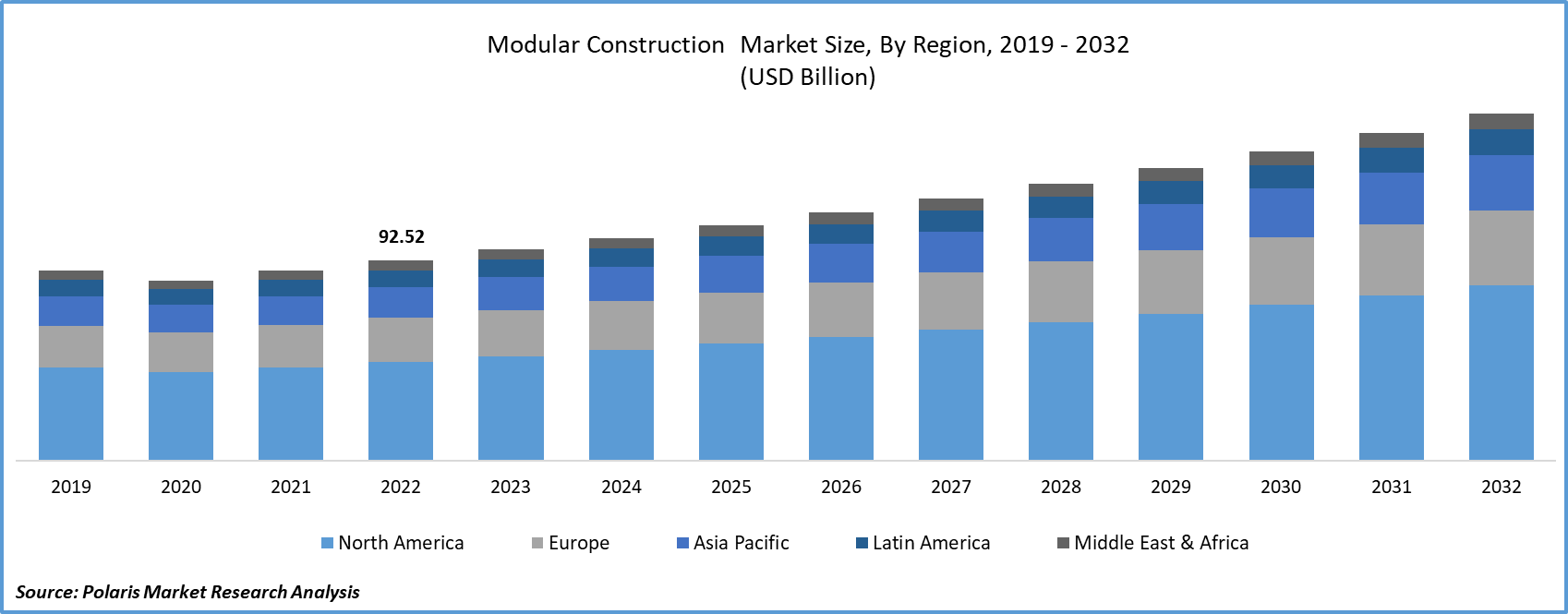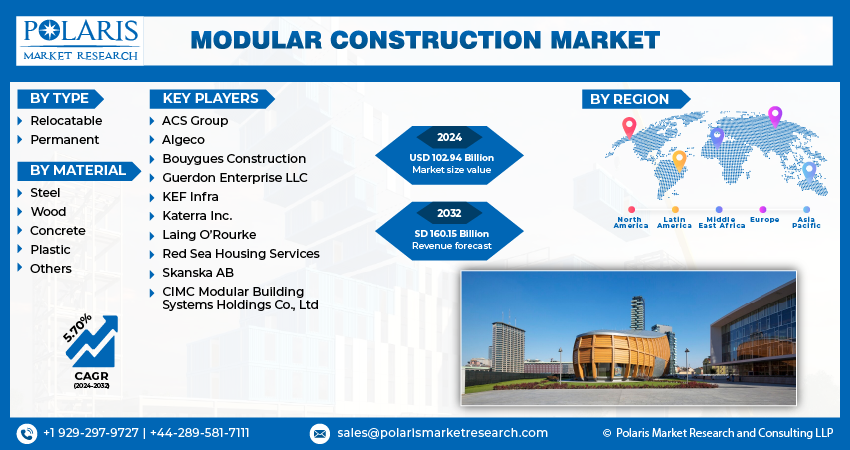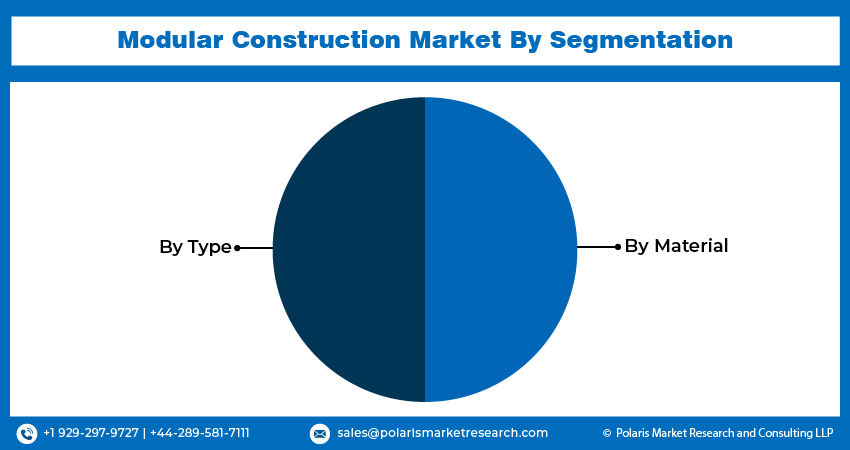
Modular Construction Market Share, Size, Trends, Industry Analysis Report, By Type (Relocatable, Permanent); By Material; By Region; Segment Forecast, 2024 - 2032
- Published Date:Jan-2024
- Pages: 116
- Format: PDF
- Report ID: PM3900
- Base Year: 2023
- Historical Data: 2019-2022
Report Outlook
The global modular construction market size and share was valued at USD 92.57 billion in 2023 and is expected to grow at a CAGR of 5.70% during the forecast period.
Modular construction is a process where a structure is assembled off-site in a controlled environment and then transported to the desired location for final assembly. This method allows for a wider range of building types and floor plans, thanks to modern technology. Modular units serve as the building blocks that are combined to create a pre-manufactured building or residence.
The research report offers a quantitative and qualitative analysis of the Modular Construction market to enable effective decision-making. It covers the key trends and growth opportunities anticipated to have a favorable impact on the market. Besides, the study covers segment and regional revenue forecasts for market assessment.
Modular construction is a procedure in which structuring is built off-site, beneath regulated plant surroundings, utilizing similar substances in outlining to the similar codes and calibers as traditionally structured spaces but in around half the time. Buildings are made in modules that, when assembled on site, mirror the similar design purpose and statements of the most contemporary site-built provision devoid of understanding.
Modular buildings can be dismantled and the modules transferred or renovated for contemporary usage decreasing the demand for raw materials and curtailing the quantity of energy disbursed to generate a building to encounter the contemporary requirement. The modular construction market sales are soaring as when building in an industrial unit, waste is discarded by recycling substances, regulating checklists, and safeguarding building substances.

To Understand More About this Research: Request a Free Sample Report
The modular building industry is poised for substantial growth, with several key factors driving its expansion. One primary catalyst is the rising industrialization and urbanization in developing nations. Furthermore, increased infrastructure spending is expected to fuel the market for modular construction in the coming years. Additionally, the adoption of modular formats in the development of commercial spaces holds the potential to further bolster this market. Work-zone safety concerns are likely to contribute to its growth in the near future. Government initiatives, such as the promotion of green buildings and waste reduction programs, could also play a pivotal role in boosting the modular construction market in the years ahead.
- For instance, in India business property leasing has witnessed 30% growth in the first quarter of 2022, and the leased area is assessed to be around 60 million sq. ft.
The increasing demand for eco-friendly and energy-efficient buildings further drives the modular construction market. Modular construction techniques enable the use of recycled and sustainable materials, thereby reducing the construction industry's environmental impact. With growing awareness about environmental sustainability and the rising popularity of Green Building certifications such as LEED and BREEAM, the modular construction market is expected to experience rapid growth throughout the forecast period.
The rising demand for high-strength materials like high-strength steel, composites, and structural steel, known for their lightweight and high-tensile properties, is expected to propel market growth.
The COVID-19 pandemic has significantly impacted the modular construction market. As the construction industry faced disruptions and challenges due to lockdowns, social distancing measures, and supply chain interruptions, modular construction emerged as a resilient and adaptable solution. With its off-site production and assembly, modular construction offered reduced on-site labor requirements, minimizing the risk of virus transmission and ensuring construction projects could continue even during lockdowns.
Additionally, the pandemic accelerated the adoption of modular construction methods in healthcare facilities, isolation units, and temporary housing solutions, showcasing the industry's ability to respond swiftly to urgent needs. As a result, modular construction is expected to continue its growth trajectory as a preferred construction method for its efficiency, cost-effectiveness, and pandemic-proof features.
The market report provides a thorough analysis of the modular construction market, covering all the major aspects stakeholders need to know. It sheds light on the key developments and trends that are anticipated to drive the modular construction industry demand over the forecast period. Besides, it maps the qualitative impact of various key factors on market segments and geographies. Furthermore, it examines the key steps taken by industry participants to strengthen their presence in the industry.

Industry Dynamics
Growth Drivers
Increasing demand for Modular Construction to erase On-site constraints fuelling Market Growth
The surging construction costs associated with green buildings have propelled a growing demand for alternative construction systems, driving market expansion. Simultaneously, the increasing interest in modular construction, which takes place under controlled conditions, circumventing on-site challenges like extreme weather, is further propelling the modular construction industry's growth. Additionally, modular construction is increasingly favored for projects with strict deadlines, making it a preferred choice in contractual construction endeavors contributing to market growth. The robust growth of the commercial sector has led to increased construction activities in areas such as schools, offices, and hotels, which, in turn, has boosted the demand for modular construction of repetitive structures, known for its quality control, thus fostering market growth.
Modular housing is a faster and more efficient way of constructing homes compared to traditional permanent housing. The process involves prefabricating building modules in a factory and then transporting them to the construction site, where they can be quickly assembled at a reduced cost. Modular buildings are gaining popularity in residential construction due to their exceptional aesthetics and superior construction quality.
Report Segmentation
The market is primarily segmented based on type, material, and region.
|
By Type |
By Material |
By Region |
|
|
|
To Understand the Scope of this Report: Speak to Analyst
By Type Analysis
The Relocatable modular construction segment is anticipated to account for the largest revenue share during the forecast period
The Relocatable modular construction segment is expected to account for the largest revenue share. The increasing popularity of relocatable modular buildings can be attributed to their versatility and cost-effectiveness. This construction method is widely embraced, particularly in fields such as education, healthcare, and retail, where there is a need for temporary structures like classrooms, clinics, and pop-up shops. Moreover, the swift provision of temporary housing makes relocatable modular buildings a frequent choice in disaster relief initiatives.
On the other hand, the permanent modular construction segment is expected to witness substantial growth throughout the forecast period. Several advantages are attributed to the utilization of this technology, such as reduced environmental impact, improved quality control, and savings in both time and costs. In contrast to traditional on-site construction methods, permanent modular construction facilitates shorter construction timelines and reduced labor expenses. This efficiency is achievable because modules are built off-site, enabling simultaneous construction both on-site and in the factory. Additionally, modular construction consumes less energy and generates less waste material during the construction process, presenting a more environmentally sustainable option.
By Material Analysis
The Steel segment is anticipated to dominate the market over the forecasted period
The steel segment is expected to dominate the market. Steel offers numerous advantages for modular construction, such as its robustness, longevity, and ability to withstand fires. Its versatility allows it to be easily molded into various forms, making it an excellent choice for modular construction projects. Furthermore, its lightweight nature simplifies both transportation and assembly. Industries that demand rapid and efficient construction, such as healthcare, education, and retail, often turn to steel modular construction for their needs.
On the other hand, the concrete segment is anticipated to experience significant growth throughout the forecast period. Concrete offers numerous advantages in modular construction, encompassing qualities such as robustness, longevity, and fire resistance. Its adaptability allows it to be seamlessly molded into various forms, making it an ideal candidate for modular construction. This enduring material is often chosen for permanent structures due to its resilience against environmental factors, pests, and mold. Concrete-based modular construction is a prevalent choice for projects demanding sturdiness and structural integrity, notably in applications like residential and commercial buildings.

Regional Insights
Asia-Pacific dominated the market in the forecast period
In 2022, the Asia-Pacific region dominated the modular construction market. The surge can be attributed to the growing need for cost-effective housing, especially in India and China. Swift urbanization, a burgeoning population, and restricted urban areas have led to a heightened demand for quick and efficient modular building solutions. Moreover, the adoption of modular construction methods by both government and private sectors for diverse purposes, such as healthcare, education, and hospitality, is projected to drive market growth in the region. Additionally, the Asia Pacific market has enticed industry players due to its abundant supply of affordable labor and raw materials.
On the other side, North America region is anticipated for the fastest growth. The construction industry has witnessed significant growth due to the increasing demand for sustainable and energy-efficient construction practices, as well as the need for cost-effective housing solutions. Modular construction is gaining popularity in the commercial sector, including offices, retail, and hotels, which is further driving the market growth. The government's support for modular construction, especially in the education and healthcare sectors, is expected to encourage regional market growth. With the growing acceptance of modular construction methods and the presence of key industry players, the United States is poised to become the largest market in the region.

Key Market Players & Competitive Insights
The market is characterized by intense competition, with established players relying on advanced technology, high-quality products, and a strong brand image to drive revenue growth. These companies employ various strategies such as research and development, mergers and acquisitions, and technological innovations to expand their product portfolios and maintain a competitive edge in the market.
Some of the major players operating in the global market include:
- ACS Group
- Algeco
- Bouygues Construction
- CIMC Modular Building Systems Holdings Co., Ltd
- Guerdon Enterprise LLC
- KEF Infra
- Katerra Inc.
- Laing O’Rourke
- Red Sea Housing Services
- Skanska AB
Recent Developments
- In May 2023, Guerdon, a modular construction company, revealed its acquisition of Champion Homes, another player in the modular construction industry, with the goal of expanding its footprint in the residential housing market.
- In March 2023, XtreeE, a construction technology firm, disclosed its collaboration with New Living, a modular construction company, to co-create 3D-printed modular housing solutions.
- In January 2023, Boxabl, a modular construction company, declared securing $50 million in fresh funding to aid the advancement of its expandable modular homes.
Modular Construction Market Report Scope
|
Report Attributes |
Details |
|
Market size value in 2024 |
USD 102.94 billion |
|
Revenue Forecast in 2032 |
USD 160.15 billion |
|
CAGR |
5.70% from 2024 – 2032 |
|
Base year |
2023 |
|
Historical data |
2019 – 2022 |
|
Forecast period |
2024 – 2032 |
|
Quantitative units |
Revenue in USD billion and CAGR from 2024 to 2032 |
|
Segments Covered |
By Type, By Material, By Region |
|
Regional scope |
North America, Europe, Asia Pacific, Latin America; Middle East & Africa |
|
Customization |
Report customization as per your requirements with respect to countries, regions, and segmentation. |
In today’s hyper-connected world, running a business around the clock is no longer an option. And at Polaris Market Research, we get that. Our sales & analyst team is available 24x5 to assist you. Get all your queries and questions answered about the Modular Construction market report with a phone call or email, as and when needed.
Navigate through the intricacies of the 2024 modular construction market with precision, thanks to the comprehensive statistics on market share, size, and revenue growth rate assembled by Polaris Market Research Industry Reports. This thorough analysis not only provides a glimpse into the historical context but also extends its reach with a market forecast outlook until 2032. Immerse yourself in the richness of this industry analysis by securing a complimentary PDF download of the sample report.
Browse Our Top Selling Reports
HERG Screening Market
AI in oncology Market
Consumer Genomics Market
Antidote Market
Infectious Disease Diagnostics Market
